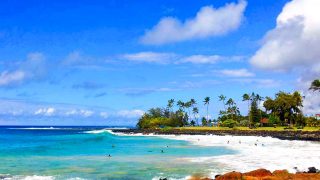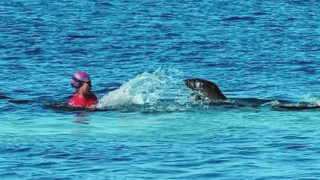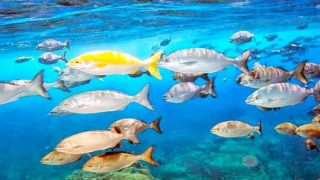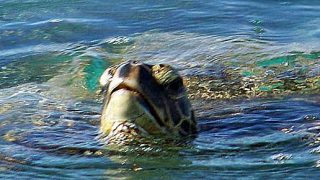Sunday morning at Poipu Beach, Kauai visitors and residents alike, including Beat of Hawaii, were treated to a memorable sight: a Hawaiian monk seal gracefully hauling itself ashore to bask in the sun and rest. Around 9 AM, we saw the monk seal come ashore directly in front of the lifeguard tower; volunteers quickly stepped in to cordon off the area, safeguarding the seal from human interference while sharing its story with onlookers.
Hawaiian monk seals are among the most endangered marine mammals in the world, with fewer than 1,600 remaining. Encounters like this highlight the delicate balance between Hawaii’s natural heritage and its busy tourism industry, exemplified at Poipu Beach. It is essential to approach these moments of interaction with care and respect.
What makes Hawaiian monk seals unique.
Known in Hawaiian as ʻīlio holo i ka uaua (a dog that runs in rough seas), monk seals are endemic to Hawaii, meaning they are found nowhere else on Earth. They are protected under the Endangered Species Act and the Marine Mammal Protection Act due to threats like habitat loss, entanglement in fishing gear, disease, and human disturbance.
These seals are remarkable for their adaptability, spending two-thirds of their lives in the ocean and the rest on land to rest, molt, and nurse their pups. Yet their survival depends heavily on public awareness and responsible behavior during interactions that can’t always be safeguarded.
How to safely view monk seals.
To ensure monk seals can thrive while sharing beaches with humans, NOAA and Hawaii’s Division of Aquatic Resources emphasize these guidelines:
- Maintain distance. Always stay at least 50 feet away and 150 feet for mothers with pups.
- Avoid noise and sudden movements. These can startle seals, causing unnecessary stress.
- Do not touch or approach. Physical interaction is both illegal and harmful.
- Report concerns. If you see a seal in distress, call NOAA’s Marine Mammal Hotline at 1-888-256-9840 or DLNR at 808-587-0077.
Following these rules protects monk seals and ensures a safer, more enriching experience for those fortunate enough to witness them.
Volunteers: guardians of Hawaii’s marine life.
This morning, the volunteers, residents, and visitors at Poipu Beach exemplified the aloha spirit in action. With the area cordoned off and volunteers educating beachgoers, they created a safe space for the monk seal to rest and for visitors to learn about its plight.
Volunteer programs are critical to conservation efforts. These dedicated individuals are pivotal in bridging the gap between human activity and wildlife preservation.
Progress toward recovery: Monk seals rebounding.
Thanks to decades of dedicated conservation efforts, Hawaiian monk seals have shown promising signs of recovery. Recent NOAA reports indicate that the population has grown steadily at approximately 2% annually since 2013, with the current estimate ranging between 1,600 and 1,750 seals. This upward trend marks a significant milestone for one of the world’s most endangered marine mammals.
In 2023, NOAA researchers documented 170 monk seal pups born within the Papahānaumokuākea Marine National Monument, a critical habitat for the species. However, challenges remain, including entanglement in fishing gear, predation by sharks, and diseases like toxoplasmosis, which are often linked to human activity.
Conservation efforts offer hope.
Organizations like NOAA and DLNR, among others, are leading the charge to protect Hawaiian monk seals. Strategies include:
- Translocation and rehabilitation. Moving seals to safer habitats or treating injured individuals.
- Disease prevention. Addressing threats like toxoplasmosis, which is transmitted via land-based pollutants.
- Public education. Empowering residents and visitors to coexist responsibly with marine life.
These efforts are showing promise, but monk seals remain highly vulnerable. Public cooperation is essential to ensure their long-term survival.
Seeing a monk seal resting on Poipu’s popular golden sands is more than a photo opportunity, including for BOH editors; it’s a call to action. As Hawaii navigates the challenges of balancing tourism with environmental stewardship, moments like this remind us of the islands’ unique and natural treasures and our collective responsibility to protect them.
Have you seen Hawaiian monk seals?
Photo © Beat of Hawaii, Poipu Beach, Kauai.
Get Breaking Hawaii Travel News







I had the amazing opportunity to see a monk seal twice in a row, early in the morning, on the shipwreck area known as the rocky area where people get married. Unfortunately, he seemed to be in a bit of trouble there, with crabs off the wall. But I also spotted him on the beach, and he was quite playful. He kept popping in and out of the water, almost like he was doing peekaboo. It was quite cute to watch!
Actually, the last time I saw a monk seal.on the beach was at Poipu Beach, just down from the lifeguard tower.
The guards quickly put up a temporary fence and though many people gathered to
Photograph it, people respected it and kept their distance
We saw 2 in December, at a beach near Poipu. They were cordoned off, and people were being generally respectful. It was fun to see one of them going (lumbering? flopping? hopping?) up the beach, maybe to get those last rays from the sun.
On our annual visits, we stay in the Kapa’a area. Usually, we see monk seals on the local beaches every year. One year, we saw an untagged monk seal and the volunteer watching over the seal said the seal probably was visiting from Ni’ihau. The year my older daughter was married on Kaua’i, my wife, younger daughter and I visited Ke’e beach. A seal came ashore about 40 yards up the beach, so my daughter and I walked up to see it (the life guards were very quick to cordon off a safety zone). Walking back to tell my wife about the experience, we saw that a second seal had come onto the beach right in front of her. She had the better experience.
It is common for Monk seals to rest on the stretch of beach along Wainiha-Haena stretch of beach, including sometimes mom’s and pups (or just moms or just pups). The “seal ladies” (as I like to call them) keep a supply of stay-away signs along the shoreline, so that they (or anyone) can plant them around the seal. Not long after, the seal return to the ocean, leaving the ring of signs/sticks.